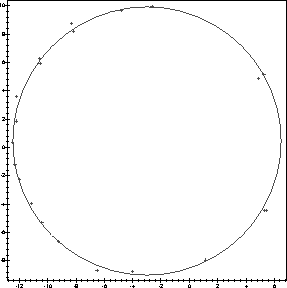In a slightly different vein, suppose that the data points {(xi, yi)} lie near a circle of unknown center and radius. Note that if we did know the center, this problem would be very simple: the desired radius would be the average distance from the points to the center. If you don't think very hard, you might suspect that the desired center would be very near the center of mass of the points {(xi, yi)}, but this will only be the case if the points are evenly distributed around the circle.
Instead, we can come up with a function that measures the error between an arbitrary circle and our data points.
Recall that the general equation of a circle centered at (a, b) with a radius of r is
One reasonable measure of the distance between the points and a circle is the ``area difference'', that is
> cpts:=circle_pts():
epsilon:=(pt,a,b,r) -> (pt[1]-a)^2 + (pt[2]-b)^2 -r^2;
![]()
> E:= (a,b,r) -> sum( epsilon(cpts[i],a,b,r)^2, i=1..nops(cpts));

> sol:= solve(diff(E(a,b,r),a)=0,
diff(E(a,b,r),b)=0,
diff(E(a,b,r),r)=0,
a,b,r);

Here we find a number of critical points for the function E, but from
physical considerations, the only reasonable choice is the circle with
center at
(- 2.987792224,.4467421770) and radius
9.471322781. In order
to see the fit, we plot the points and the circle. Note that we represent
the circle parametrically, and use subs to substitute the desired
solution.
> pp:=plot(cpts,style=point,scaling=constrained,axes=boxed):
cp:=plot(subs(sol[6],[a+r*cos(t),b+r*sin(t),t=0..2*Pi])):
plots[display](pp,cp);

The fact that there is only one interesting critical point is no accident,
however. If we let
k = a2 + b2 - r2, then the resulting error function
H(a, b, k) = E(a, b,![]() ) is quadratic in a, b, and k,
and so we really only need to solve a linear system. It is easy to check
that this new functional H still satifies all the criteria we wanted (that
is
H(a, b, k) = 0 if and only if all the data points lie on the circle
C(a, b, k), H is non-negative, and it is smooth), so fitting a circle
becomes a linear problem after all. The reader should verify that, in fact,
the unique minimum of H corresponds exactly to the critical points
the original function E for which r
) is quadratic in a, b, and k,
and so we really only need to solve a linear system. It is easy to check
that this new functional H still satifies all the criteria we wanted (that
is
H(a, b, k) = 0 if and only if all the data points lie on the circle
C(a, b, k), H is non-negative, and it is smooth), so fitting a circle
becomes a linear problem after all. The reader should verify that, in fact,
the unique minimum of H corresponds exactly to the critical points
the original function E for which r![]() 0.
0.
The interested reader might want to consider a similar approach to fitting
other conic sections, such as an ellipse or a hyperbola, to given data. Do
you expect to be able to make the problem linear, as in the case of the
circle?